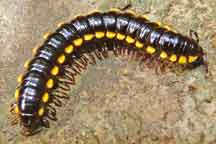Geetha Iyer
 This animal was a favourite among children when I was growing up. At our house in Trivandrum, millipedes, centipedes, scorpions, spiders, etc., were creatures that one bumped into everyday. They were treated with due respect and care so that we could coexist without harming each other. The centipedes that were adventurous enough to enter the living rooms would meet with harsh treatment. The harmless black with yellow millipede would be all over the place, welcomed, a plaything for us. They used to be the centre of such creative games that I am sure the millipedes were annoyed to a great extent. Sadly they are no longer so common in our urban households. Many children (adults are no better) confuse a millipede for an earthworm. I was surprised to learn that in India it is hard to locate a scientist studying the millipede.
This animal was a favourite among children when I was growing up. At our house in Trivandrum, millipedes, centipedes, scorpions, spiders, etc., were creatures that one bumped into everyday. They were treated with due respect and care so that we could coexist without harming each other. The centipedes that were adventurous enough to enter the living rooms would meet with harsh treatment. The harmless black with yellow millipede would be all over the place, welcomed, a plaything for us. They used to be the centre of such creative games that I am sure the millipedes were annoyed to a great extent. Sadly they are no longer so common in our urban households. Many children (adults are no better) confuse a millipede for an earthworm. I was surprised to learn that in India it is hard to locate a scientist studying the millipede.
Millipedes are harmless detritivores that were among the first animals to colonize the land during the Ordovician period 450 MYA. Being detritus feeders and sometimes herbivores, it is believed that millipedes may have played a major role in soil formation and nutrient cycling during the paleozoic era. They belong to the Phylum Arthropoda, Sub-phylum Myriapoda and Class Diplopoda.
Etymology and the legs
The word millipede comes from two latin words ‘milli’ and ‘pede’ meaning thousand and foot respectively. Does that make a millipede a thousand footed animal? Certainly not! But millipedes do have a lot of legs on their body. There are two pairs of legs seen for each segment of the body. The segments are usually referred to as rings. There are two pairs of legs present because each segment is actually two fused into one. The number of segments in the body could vary anywhere from 12 to more than 100. Illacme plenipes holds the record for the millipede with the most number of legs. There are a larger number of individual parts to each leg; more than what you would find in an insect.
The author is a consultant for science and environment education. She can be reached at scopsowl@gmail.com.
